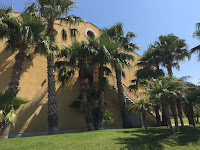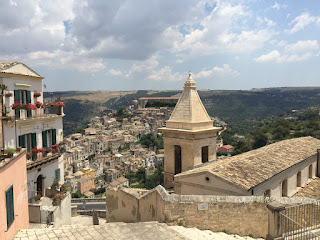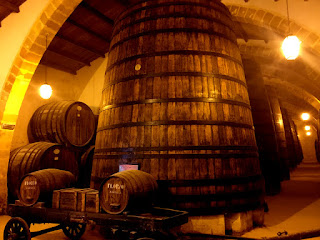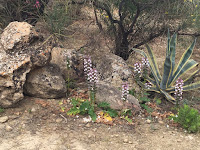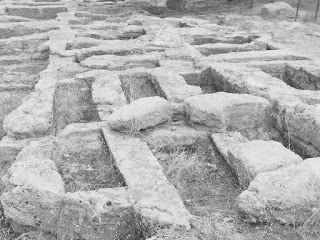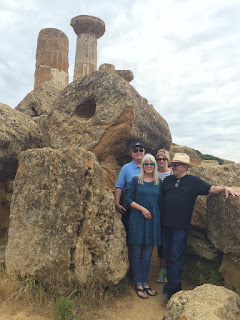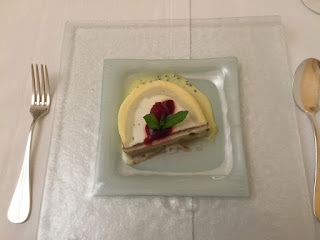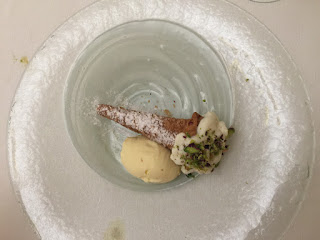Donnafugata Golf Resort & Spa located in the heart of Val di Noto was our base from which to wander, to wonder, and to relax for the next 3 days. The order of our activities was to be determined.
More than a resort, it looks rather like a small Mediterranean village with tile roofs, low houses painted in yellow or orange, and little gardens of lavender, rosemary and Mediterranean flowers.
... and then a spectacular carob tree.
Everything was immersed in total silence.
We enjoyed a lavish breakfast buffet each morning on a beautiful terrace to the resort's restaurant Il Fico d'India.
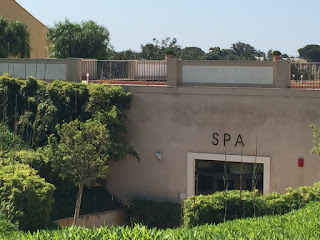
The entrance of the Spa is surrounded by a small wood of super-green bamboo trees.
Joan
Gus
This is earthquake country, and one earthquake in particular shaped it, when a huge tremor in 1693 flattened more than 100 towns. Undaunted, the local aristocracy rebuilt them in the style of the time, an elaborate confection of carved stonework known as Noto baroque – an extraordinary feat of reconstruction that included building 600 churches and countless palaces and other structures, all within the space of 50 years.
Among the towns destroyed in the earthquake were the towns of Modica and Ragusa. Both towns were rebuilt in the then-current Baroque style, with local interpretations that became known as Sicilian Baroque. Along with six others (Caltagirone, Militello Val di Catania, Catania, Noto, Palazzolo Acreide, and Scicli) Modica and Ragusa were named a UNESCO World Heritage Site as the "culmination and final flowering of Baroque art in Europe."
Two days later we all headed off to Ragusa. We parked in "Upper" Ragusa and without any destinations or sites in mind wandered the neighborhoods.
Inspector Salvo Montalbano is a fictional character created by Italian writer Andrea Camilleri in a series of novels and short stories. The series is shot almost entirely in Ragusa and surrounding towns.
Yet another day in Val di Noto we headed off to Syracuse or Siracusa.
Ortigia is a very charming city. Its principal buildings, and many others, have been carefully maintained or restored and the fact that it is essentially a pedestrian city gives it a special character that it shares with places like Venice. We serendipitously chose to visit today, 2nd June, which is Republic Day in Italy. There were crowds but it was not crowed.
More than a resort, it looks rather like a small Mediterranean village with tile roofs, low houses painted in yellow or orange, and little gardens of lavender, rosemary and Mediterranean flowers.
... and then a spectacular carob tree.
 |
| Carob Tree |
Everything was immersed in total silence.
 |
| Our walk to breakfast |
We enjoyed a lavish breakfast buffet each morning on a beautiful terrace to the resort's restaurant Il Fico d'India.
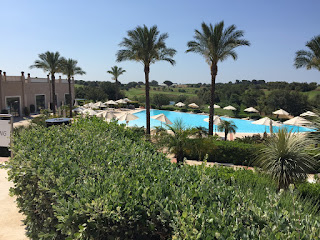 |
| Infinity swimming pool. Spa to the left and the golf course behind. |
 |
| Dinner at the Club House 19th Hole |
For our primo we had a wonderful dish of pasta Orecchiette with Pistachio Pesto (Americanized recipe).

The entrance of the Spa is surrounded by a small wood of super-green bamboo trees.
6:30 - Luxury Aromatherapy Massage
"Apart from relieving stress and muscles
tension, improving sleep and eliminating liquids,
this massage offers a feeling of well-being, for a
complete regeneration."
6:00 - Man Experience - Facial Cleansing
"Accurate and deep facial cleansing periodically
recommended for male skin. It purifies the skin
preparing it for subsequent specific treatments."
7:00 - Super - Man Massage
"A total body deep massage, performed with
soft manipulations to stretch the contracted
muscles, with warm oils, giving a pleasant sense
of relaxation and reinvigoration throughout the
body."
This is earthquake country, and one earthquake in particular shaped it, when a huge tremor in 1693 flattened more than 100 towns. Undaunted, the local aristocracy rebuilt them in the style of the time, an elaborate confection of carved stonework known as Noto baroque – an extraordinary feat of reconstruction that included building 600 churches and countless palaces and other structures, all within the space of 50 years.
Among the towns destroyed in the earthquake were the towns of Modica and Ragusa. Both towns were rebuilt in the then-current Baroque style, with local interpretations that became known as Sicilian Baroque. Along with six others (Caltagirone, Militello Val di Catania, Catania, Noto, Palazzolo Acreide, and Scicli) Modica and Ragusa were named a UNESCO World Heritage Site as the "culmination and final flowering of Baroque art in Europe."
While Gus and Joan decided to take another "day off" and just hang by the pool and read Curt and Lynn were off to Modica. A town famous for its chocolate and Baroque architecture. Modica is divided into two parts, “higher” Modica and “lower” Modica, which are connected by numerous flights of steps (Gus and Joan's absence somewhat respectful to Joan's upcoming hip replacement surgery in just over one month) and boasts fine late-Baroque architecture.
Chocolate, invented by the Aztecs, was brought to Europe from Oaxaca – which was under Spain, just like Sicily at the time. Antica Dolceria Bonajuto started making chocolate in 1880, and has followed the same method ever since: cocoa seeds are ground, without eliminating any of the fatty “butter”; slowly heated; mixed with sugar; ingredients such as vanilla or cinnamon are added; finally kneaded & beaten.
 |
| Curt in line to buy chocolate bars at Antica Dolceria Bonajuto |
Two days later we all headed off to Ragusa. We parked in "Upper" Ragusa and without any destinations or sites in mind wandered the neighborhoods.
Inspector Salvo Montalbano is a fictional character created by Italian writer Andrea Camilleri in a series of novels and short stories. The series is shot almost entirely in Ragusa and surrounding towns.
Yet another day in Val di Noto we headed off to Syracuse or Siracusa.
| Our wonderful guide, Eva Greco A personable, well-informed Siracusana who is remarkably passionate about her hometown. |
We began our tour with the island of Ortigia, Siracusa’s nucleus for thousands of years. We found parking in an area where parking spaces were scarce if not impossible to find and capture. Parked, we headed off on foot ...
| Ruins of the Doric Temple of Apollo dating from the 6th century B.C. |
Much of the island’s charm lies in wandering down narrow medieval lanes, past romantically-crumbling – or lovingly-restored – Baroque palaces and churches.
Ortigia is a very charming city. Its principal buildings, and many others, have been carefully maintained or restored and the fact that it is essentially a pedestrian city gives it a special character that it shares with places like Venice. We serendipitously chose to visit today, 2nd June, which is Republic Day in Italy. There were crowds but it was not crowed.
We soon found ourselves in Piazzo Duomo, a refined elegant semi-elliptic square surrounded by the most elaborate buildings on the island – the Cathedral of Syracuse (Cathedral of Santa Maria delle Colonne), Palazzo Senatorio, now housing city hall, Palazzo Beneventano del Bosco, Palazzo Arcivescovile, and the Chiesa di Santa Lucia alla Badia. The buildings and the flagstones of the piazza are all made from a pale local stone that gives the overall picture a pleasing uniformity. A few citrus trees poke their tips over the wall of a high garden overlooking the piazza.
| The Piazzo Duomo from left to right Palazzo Senatorio, the Cathedral of Syracuse,, Palazzo Arcivescovile, and the Chiesa di Santa Lucia alla Badia |
The cathedral stands on the site of the 5th century BC Temple of Athena. It is unknown when The Temple of Athena became a Christian church but the earliest known date is 640 AD. Around this time, the Bishop of Syracuse moved the Duomo of Syracuse to the site of the temple. The structure was destroyed by an earthquake in 1543. Later, its Norman façade was replaced with a Baroque façade designed by Andrea Palma in the 18th century.
Although not conspicuous, in the above photo, the "double cross" on the top of the cathedral was particularly interesting to Joan. After asking Eva - "What is the significance of a cross with two cross-bars to Christians? Does it carry different symbolism than a normal cross?" Rather than answering the questions, Eva stated that Joan had "occhio lungo" or a "long eye"; Joan had a discerning eye and saw or noticed things that many people miss or fail to see.
| The nave of the Cathedral of Syracuse. The pillars were created by opening the walls of the internal cella of the Temple of Athena. |
| Chapel of St. Lucy St Lucy (Santa Lucia) is the patron Saint of Syracuse, where she was born and martyred in 310 AD. Hear Mario Lanza sing "Santa Lucia" |
| Palazzo Arcivescovile Lemon trees poking above the wall. Behind the wall is a splendid terrace and hanging garden. |
| Chiesa di Santa Lucia alla Badia containing a large Burial of St. Lucy by Caravaggio. The façade of the church is crossed by a wide balcony from which the cloistered nuns could observe the ceremonies in the in the piazza. |
No photos were allowed inside the church.
Along the way from the Piazzo to the west coastline of the island Gus asked Eva about the Sicilian economy and employment opportunities. Eva, without hesitating , said that "the economy is very difficult but getting better, however, job opportunities continue to be scarce, especially for our 'twenty-somethings' who are living with their parents and are delaying getting married and starting families." It is estimated that for every 100 working Sicilians, there are 28 people seeking a job and another 22 willing to work but not actively searching, the highest level among all 28 European Union countries; unemployment for those under 30 (33% of Sicily's population) is even higher. See Svimez Report 2015 for more detailed comments on the economy of Southern Italy (Abruzzo, Basilicata, Calabria, Campania, Molise, Puglia, Sardinia and Sicily). On a brighter note, tourists, particularly foreigners, continue to play a pivotal part in Sicily's economy and Eva is busier this year than she can remember.
| Fonte Arethusa Studded with puffy-headed, willowy Egyptian papyrus.
|
Legend has it that Arethusa, originally an Arcadian nymph, fled underwater to Siracusa in an attempt to rid herself of the persistent amorous advances of the river God Alpheios. The Goddess Artemis transformed her into the fresh water spring that we can see in the photo above. All was in vain, however, as Alpheios located his prey and mixed his own waters with hers. Legend also has it that the spring is directly connected under the sea to the river at the sanctuary of Olympia.
Leaving Ortigia we followed our guide, Eva on her Vespa, across Ponte Umbertino and through the sprawl of a modern city to the Neapolis Archaeological Park and the ancient Greek Theater.
| Oh, what a setting. Greek Theater on Temenite Hill Can you see the Mediterranean Sea in the middle left of the photo? The curtain rises as the sun sets and a magical performance begins. |
Like all Greek Theaters, this theater is built into a hillside. This was a necessity because the Greeks needed a hillside setting to support the theater seating. It wasn't until the Romans later began building with arches and concrete that a freestanding theater, like the Coliseum was possible. The semi-circle shape was used to aid with acoustics. Constructed in 474 BC and expanded in the 3rd and 2nd centuries BC. Its size was very impressive despite the fact that much of the stone was removed to build the walls around Ortigia between 1520-1531. The tradition of performing ancient Greek plays was revived in Syracuse in 1914. Plays first performed here over 2,500 years ago are now performed at sunset, in Italian (with translations by famous writers such as Salvatore Quasimodo), without sound systems because of the quality of the theatre's acoustics. Each theater season begins in May and ends in July, attracting thousands of spectators from all over the world.
| Scenography from Aeschylus’ The Suppliants the first play performed of the 2015 season. |
| Ancient building nearby and northeast of the theater. |
| The rectangular holes in the rock are niches where paintings and votive tablets honoring Syracusan heroes were displayed. |
 |
| Latomia del Paradiso (Paradise Quarry) The deep limestone quarry to the east of the theater is a peaceful and green spot, filled with oleander, and bay trees, citrus trees, and olive trees. |
Latomia del Paradiso is Syracuse's largest and most famous quarry. Following the Athenian expedition to Sicily the quarry (along with several other quarries in and around Syracuse) became the place where the 7,000 defeated Athenian soldiers were jailed. Cold in winter and hot in summer, being imprisoned in the quarries was tantamount to a death sentence; the prisoners were left to die of hunger and exhaustion, with no possibility of escape.
| Ear of Dionysius A grotto carved into the rock wall of Latomia del Paradiso. Named by the painter Caravaggio because of is shape like an elfin ear and the amazing acoustics, which supposedly allowed Dionysius to eavesdrop on prisoners housed in the quarry. |
We took our lunch at Ristorante Red Moon. The restaurant was filled with locals enjoying pasta and seafood at reasonable prices. It is quite casual and unsophisticated, but the seafood was fresh and it was a great value. On the downside ...
- the day was hot and the tent (the dining area is actually in a tent) was full to capacity and the space was not adequately ventilated; in spite of several fans we suffered the heat,
- busy, loud, and chaotic with lots of families and several large groups,
- the service was unapologetically slow and a bit "strange",
- the kitchen was not serving pasta with sea urchins (Spaghetti ai ricci di mare) by late April the "urchin season" is over, and
- the dishes that we did order (pasta with squid ink, fritto misto, braised octopus, all washed down with many cold beers) although fresh, were simply okay!
Red Moon turned out to be a favorably reviewed (Fodor's, Lonely Planet, eGullet, and TripAdvisor) restaurant which failed to deliver.
We wandered, we wondered, and we have relaxed. Tomorrow we head to the northeast of the island and will stay in a boutique country hotel set amidst a Sicilian Estate in the foothills of Mount Etna.

